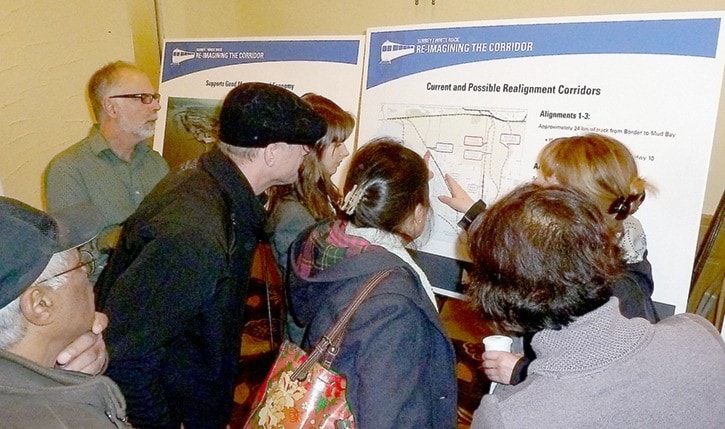The timing of a rail-safety public forum that advanced the idea of relocating the main BNSF route off the waterfront in favour of a system of pedestrian trails – and suggested four possible inland realignments – could have been better, according to Surrey Coun. Linda Hepner.
Hepner, who chairs the city’s agricultural and food security committee, said this week that any relocation of the route could have significant implications for Surrey’s agricultural land – and that farmers would need to be part of the discussion.
Hepner said while her committee subsequently received the presentation from staff – included in the most recent committee minutes approved by council Monday night – it “would have been nicer to have the presentation before the fact.”
Coun. Tom Gill, chair of the city’s transportation and infrastructure committee, said Monday he felt city staff had “dropped the ball” in not presenting the ideas to his committee before the Nov. 26 public forum – which included presentations from Surrey Mayor Dianne Watts and White Rock Mayor Wayne Baldwin – for which he said he agreed to act as master of ceremonies “at short notice.”
Hepner said the idea of a “Utopia” without tracks on the waterfront has come up many times since she was first elected in to Surrey council in 1985.
“If we advanced in any way the relocation of the tracks, it would require a willing partner in the BNSF and a funding source,” she said, noting discussion is premature without these “essential elements.”
Moreover, she noted, the issue is a national one – not just a concern in Surrey and White Rock.
“I sit as a member of the Federation of Canadian Municipalities, which has had a national rail safety committee since the Lac Mégantic disaster,” she said.
“The question arises that, if we’re going to move our rails, who else in this nation may wish to move theirs? It’s such a big conversation and we’re a ways away from that coming to fruition.”
She’s said she’s also concerned that “any time we have a significant requirement for new infrastructure, it comes at the expense of agricultural land.”
Some of the routes shown as potential realignments are “beyond 70 per cent in agricultural land,” Hepner said.
It might seem easy to utilize for rail relocation, but it might not be the best use of resources, she said, noting it would set a precedent.
“Rail corridors always attract industry, there’s no question about that,” she said, adding that potential ag-industrial uses might need to be part of the discussion.
“It’s too early to have those conversations,” Hepner said. “But certainly we want to have the agricultural community at the table when we have them.”
